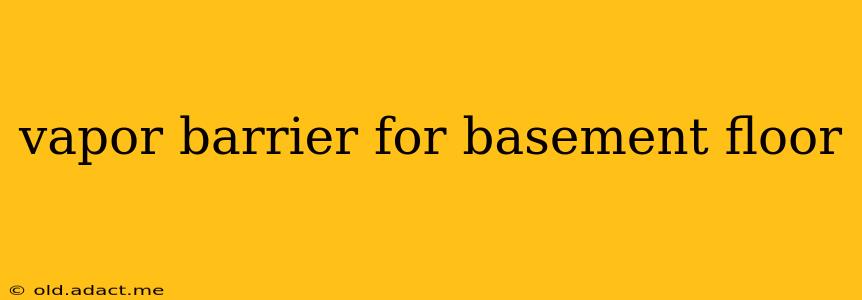A damp basement is a homeowner's nightmare, leading to musty odors, mold growth, and structural damage. One crucial step in preventing these issues is installing a proper vapor barrier on your basement floor. This comprehensive guide will explore everything you need to know about basement floor vapor barriers, answering common questions and helping you make informed decisions for your home.
What is a Vapor Barrier and Why is it Important for a Basement Floor?
A vapor barrier is a material designed to prevent the passage of moisture vapor. In a basement, this is crucial because moisture can migrate from the ground up into your living space. This moisture can lead to several problems:
- Mold and mildew growth: Damp conditions are a breeding ground for mold and mildew, which can cause respiratory problems and damage your belongings.
- Structural damage: Excess moisture can weaken concrete and wood, leading to cracks, rot, and other structural issues.
- Unpleasant odors: Dampness creates a musty smell that permeates your basement and can even affect the rest of your house.
- Pest infestations: Damp basements are attractive to insects and rodents.
By installing a vapor barrier, you create a moisture-resistant layer that significantly reduces the amount of moisture that enters your basement. This proactive measure protects your home and your health.
What are the Different Types of Vapor Barriers for Basement Floors?
Several materials can effectively serve as a vapor barrier for your basement floor. The best choice depends on factors like budget, ease of installation, and the specific conditions of your basement. Common options include:
- 6-mil polyethylene sheeting: This is a cost-effective and widely available option. It's relatively easy to install but can be prone to tearing.
- 10-mil polyethylene sheeting: A thicker and more durable option than 6-mil sheeting, offering better protection against tears and punctures.
- Vapor barrier paint: This is a specialized paint applied directly to the concrete floor. While convenient, it's typically less effective than sheeting.
- Specialized basement membrane systems: These are more complex and expensive systems that offer superior protection against moisture. They often include multiple layers and may require professional installation.
Choosing the right type of vapor barrier is crucial for its long-term effectiveness. Consider consulting with a qualified contractor for advice specific to your basement's conditions.
How Do I Install a Vapor Barrier on My Basement Floor?
The installation process varies slightly depending on the chosen material, but generally follows these steps:
- Prepare the surface: Clean the concrete floor thoroughly, removing any debris, dust, or loose particles. Repair any significant cracks or holes.
- Lay the vapor barrier: Overlap the sheets of polyethylene sheeting by at least 6 inches, sealing the overlaps with vapor-barrier tape. Ensure the edges are sealed to prevent moisture from seeping in. If using paint, follow the manufacturer's instructions carefully.
- Install flooring: Once the vapor barrier is securely in place, you can install your chosen flooring material. This could be anything from tile to carpet, but select materials suitable for basements that can handle moisture.
Remember to prioritize proper sealing to maximize the vapor barrier's effectiveness.
Does a Vapor Barrier Prevent Flooding?
No. A vapor barrier is designed to prevent moisture vapor from migrating through the concrete floor, not to prevent water from flooding into the basement. A vapor barrier is a crucial part of basement moisture control, but it's not a substitute for proper drainage and waterproofing measures. Consider sump pumps and exterior drainage solutions if your basement is prone to flooding.
What are the Signs of a Failing Vapor Barrier?
A failing vapor barrier often reveals itself through these signs:
- Musty odor: A persistent, unpleasant smell indicates moisture trapped beneath the barrier.
- Mold growth: Visible mold indicates moisture intrusion.
- Dampness on the floor: Feel the floor for dampness, especially in areas where the barrier might be damaged.
- Peeling paint or wallpaper: This is a sign of moisture problems in general, and could indicate failure of the vapor barrier.
If you observe any of these signs, it's essential to investigate and potentially replace the damaged barrier.
Can I Install a Vapor Barrier Myself, or Should I Hire a Professional?
While DIY installation is possible for some types of vapor barriers, especially polyethylene sheeting, professional installation may be beneficial for more complex systems or for larger basements. A professional can ensure proper installation and address any underlying moisture problems. Weigh the costs and your skillset before deciding.
By understanding the importance of a vapor barrier, selecting the right material, and following proper installation techniques, you can significantly improve your basement's environment, protecting your home from moisture damage and ensuring a healthier living space. Remember to always consult with a qualified professional if you have concerns or uncertainties.
